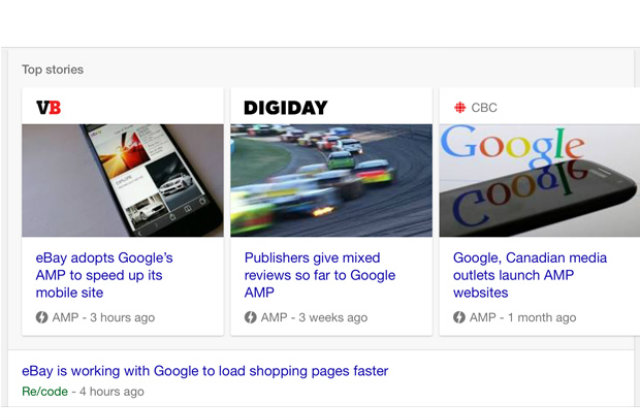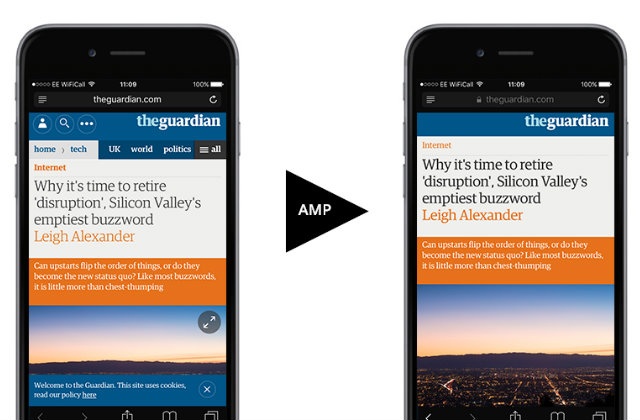
What is Google AMP Project? Mobile devices have changed the way we access information. As a consequence, they have disrupted the news and communication industry, promoting new tools to create and share contents.
The problem is: While publishers now use the mobile web to reach readers, the customer experience is often discouraging, and leaves a lot to be desired. As usual, people and technology evolve at a quicker pace than companies. Let’s get back to the question, then: Is Google AMP the next revolution for mobile marketing?
When you search for something on Google using your smartphone, you may stumble upon some boxed articles at the top of the result page. They come with a mysterious acronym, AMP. It stands for Accelerated Mobile Pages, and it aims to become the new standard for the mobile web.
Almost one year ago (October 7, 2015) on the pages of Google’s official blog was published and article titled “Introducing the Accelerated Mobile Pages Project, for a faster, open mobile web.” A few hours later, digital marketers already had shivers of terror down their back.
They were just recovering from the smash caused by the mobile-friendly algorithm, and they feared another SEO revolution. A small step for Google, a huge workload for brands. Despite everything, however, the AMP Project has gone on the backburner, and marketers’ attention has been drawn by other priorities (i.e. Pokemon Go).
But it was only a matter of time before AMPs would come back as an urgent topic. And here we are, one year later, witnesses of the official launch of the project. The assumption is that customers do not have time to waste. In a world of overabundant information, they want to find the right content at the right time.

Speed is all that matters in the mobile era. This is true for users, and even more true for publishers:
"Every time a web page takes too long to load, they lose a reader - and the opportunity to earn revenue through advertising or subscriptions. That's because advertisers on these websites have a hard time getting consumers to pay attention to their ads when the pages load so slowly that people abandon them entirely."
The big Internet players know that time is money, and they are competing on developing a technology that will allow users to load contents instantly. Facebook Instant Articles is yet another example, a cornerstone of Mark Zuckerberg’s project to create a self-sufficient ecosystem for its customers.
The Accelerated Mobile Pages Project is an open source initiative that embodies the vision that publishers can create mobile optimized content once and have it load instantly everywhere. The project relies on AMP HTML, a new open framework which allows websites to build lightweight pages:
"We want web pages with rich content like video, animations and graphics to work alongside smart ads, and to load instantaneously. We also want the same code to work across multiple platforms and devices so that content can appear everywhere in an instant - no matter what type of phone, tablet or mobile device you’re using."
Like any significant new technology, accelerate mobile pages are still surrounded by a halo of doubts. How do they work? How will Google rank them in the result pages? Should companies jump on the bandwagon?
Here are the most common concerns, and everything you need to know to face this challenge well prepared.
HOW WILL AMP IMPACT SEO
Let’s start with the obvious question. How are AMP and search engine optimization connected? Right now AMP is not directly a search engine ranking factor but it is evident that this technology will affect the rankings one way or another.
What we know now is that “AMPs are completely separate from a typical mobile site. The mobile and AMP versions will each be annotated separately as alternates." (Jim Robinson, founder and CEO of ClickSeed). The same content will have two different versions, then.
The fact is that speed is one of the most critical elements in how Google ranks the different pages. AMP focus on speed and ease of use, and it is likely that they will indirectly influence where Google places the two different versions in the results:
"If we had two articles that from a signaling perspective scored the same in all other characteristics but for speed, then yes, we will give an emphasis to the one with speed because that is what users find compelling." (Richard Gingras, senior director of news and social products at Google)

WHAT TYPES OF BRAND SHOULD USE AMP?
Right now the AMP results focus on two different types of contents: news and e-commerce results. Informative contents are ideal for accelerated mobile pages, and it is not by chance that the sites currently using AMP are news-based publishers like Google News, Forbes, Time Inc., Buzzfeed.
If you are a publisher or simply have a company blog and you want to grow your audience, you should definitely think about implementing AMP as a part of your content marketing strategy.
There is also another type of brand that might find AMP useful, e-commerce websites. First in line we find eBay, one of the most recent adopters of the technology, with over 8 million AMP-based nodes in production. The idea of having a carousel of product at the top of the result page is tempting, isn’t it?
WHAT ARE THE PROS AND CONS OF AMP?
It will take some time to fully understand the implications and the extent of this evolution. It will surely require time, budget and study to the companies that want to embrace the power of AMPs. Being a separated and unique platform, it is not something that you just improvise and decide to do from one day to another.
The pros are many. The most evident is the potential increase in mobile traffic, given that AMP is another door to convey visitors to the official site. Other benefits could be the decrease in bounce rates, due to a higher load speed; an increase in conversions, thanks to a better digital customer experience; and the eternal Google’s goodwill that might have good effects on the digital presence as a whole.
What about the cons? First, AMPs are only served on mobile devices. If your mobile presence is not the core of your strategy, you will not see miraculous results. Second, it takes work and resources to implement the technology, and that translates into investments. Stay prepared to involve the IT crowd, because AMP means code.
Third, not all kinds of contents work with AMP (for instance, you might have problems with images, presentations, video, pop-ups and subscription forms). Last but not least, AMPs have weak analytics insights right now, and even advertising is all but simple (even though Doubleclick by Google has just announced AMP for Ads). If you plan to play with this technology and get actual results, then, prepare to sweat.
IS AMP THE FUTURE OF MOBILE MARKETING?
Given everything we have said, is AMP technology the real deal for the future of mobile marketing? The truth is, we do not know. Behind this new approach to mobile contents, we find Google, and that is usually synonymous with revolution. But we know that not every single revolution is successful, as stated by all those projects that the Big G has canceled or downgraded in the recent years.
The accelerated mobile pages have the potential to disrupt the web, but it has to face fierce competition, with Facebook (with Instant Articles) and Apple (with Apple News) already involved in the mobile battlefield. Who will win the speed race to the new standard?
If you want to know more or get started with AMP, check the official page of the project.
Need more insights on how to engage millennial customers? Download The Mobile Engagement Playbook, a collection of relevant insights that'll help you to overcome the challenges of the digital transformation and grow your business exponentially.



 Your magnifing glass to deeply understand your users and increase the value of each relatonship.
Your magnifing glass to deeply understand your users and increase the value of each relatonship. Listen to the voice of your customers deeply to understand what they truly want.
Listen to the voice of your customers deeply to understand what they truly want. The Lead Generation Platform to get leads from anonymous traffic on your website.
The Lead Generation Platform to get leads from anonymous traffic on your website.  Understand the behavior of people in physical spaces and monitor safety requirements.
Understand the behavior of people in physical spaces and monitor safety requirements. The Digital Commerce Platform designed to follow the most modern technological standards..
The Digital Commerce Platform designed to follow the most modern technological standards.. The XReality platform to tell brand and product stories by connecting physical and digital worlds.
The XReality platform to tell brand and product stories by connecting physical and digital worlds. Points, rewards, levels, badges, missions: a world of nudges to nurture your customer community.
Points, rewards, levels, badges, missions: a world of nudges to nurture your customer community. Discover all the other solutions!
Discover all the other solutions!









